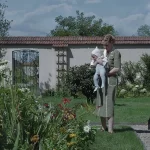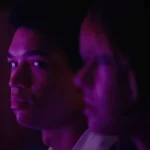Criterion Prediction #12: Distant Voices, Still Lives, by Alexander Miller
Title: Distant Voices, Still Lives
Year: 1988
Director: Terence Davies
Cast: Pete Postlethwaite, Freda Dowie, Lorraine Dowie, Lorraine Ashbourne, Angela Walsh, Dean Williams, Jean Boht.
Synopsis: Distant Voices, Still Lives spans over a decade, chronicling the lives of a middle class Liverpool family. The wife and three children live in fear of their tyrannical, abusive father played with staggering fury by Pete Postlewaite. The first part – “Distant Voices” – presents the remaining family members; the mother and three children are grown up, mulling over Father’s passing, recalling his mercurial temper and abuse throughout their lives. Later, in “Still Lives” we find the family moving on with lives of their own, Mother (Freda Dowie, like “Father,” is cast as “Mother”) who seems to have a more spirited life free from the tyranny of Father. Their lives during England’s postwar years releases them from the confinement of their home into their communal neighborhood where the local pub that is the place of congregation. They find peace of mind while the memory of Father still looms over their lives. The pillar of escapism throughout their lives comes from impromptu singing and dancing. Music is indicative of their existence from childhood onward. The simple act of caroling a song has the power to pass the time, ease the inherent fear of war (a standout scene occurs in a shelter during an air raid), even subdue the brutality of their domineering patriarch. Their bleak existence bares rays of hope as they gather for radio shows, hobnob with neighbors and participate in religious ceremonies.
Critique: When you ask someone about “British Cinema” they’ll likely imagine Victorian or Medieval Melodramas, Kitchen Sink Realism, Monty Python or Hammer. Is it possible that the dreamily augmented realism of Terence Davies’ work was too hard to sell to the US market? The proceedings of Davies’ Distant Voices, Still Lives is in some ways easy to summarize, and yet nearly impossible to categorize. So when you hear “British Realism” as a way to describe this movie, you don’t think you’ll experience such deliberately artful compositions and atmosphere. Davies’ stylistic devices fuel his films with such ease that his dense narrative and dark subject matter flow without the downbeat residuals you might get from the likes of Ken Loach, or Mike Leigh. His contrasting techniques (that would otherwise suffer in lesser hands) that might seem at odds fall perfectly into place; mercurial violence is followed with static compositions (evoking silent cinema, or still portraits), staging is presented in slow dissolves, and most strikingly the harsh realism is executed with dreamy resonance. As tragic as the narrative may sound, Distant Voices, Still Lives is an enlightening film whose dual segments (shot two years from each other) may diverge in tone but work in harmony. Recounted from Davies own life (whose experiences were worse than those in the film), Distant Voices, Still Lives is a stirring piece of cinema that transposes the viewer to a time and place distinct and personal to the director’s life.
Why it Belongs in the Collection? At the risk of sounding like a spoiled brat, I kept saying to myself while I was watching the Criterion Blu-Ray of The Long Day Closes “imagine if they did the same with Distant Voices, Still Lives?” Well, in my opinion, they can, and they should release this classic Terence Davies film. This film is the director’s strongest work. Given the significance, and relationship of both films it’s almost impossible to think of The Long Day Closes without Distant Voices, Still Lives as a companion. When Criterion announced the Dual Format (RIP) release of The Long Day Closes it was an important moment in expanding their library by including Terence Davies. The film is available on VHS and a region 2 DVD which is acceptable only in that the film exists on DVD. This is a film that boasts some incredible visual prowess, and the cinematography is first-rate. The images pop on this poorly transferred Region 2 DVD, however they would explode on Blu-ray. Like a lot of European “arthouse” films from the eighties and nineties Distant Voices, Still Lives is in need of restoration; and fitting as well as it does in the Criterion wheelhouse this title feels more like an inevitability than a prediction.






























